Mathematical Mysteries of Rapa Nui with Classroom Activities: Mathematical Mystery 1 – Rongorongo
The first mystery we will discuss is the unique form of writing, called Rongorongo, that was used by the sacred people in Rapa Nui. When slave traders from Peru abducted or killed nearly half the population of Rapa Nui in 1862, the ability to read Rongorongo was lost. It remains one of the partially undeciphered scripts in the world.
Fewer than 30 objects containing Rongorongo writing—mostly wooden tablets—have been discovered. The Rongorongo characters appear in lines, with alternating orientation. One theory is that two facing people read from the tablet; another is that the tablet could have been read by one person and turned when the end of the line was reached. The tablets are thought to have been used during special ceremonies by a few elite men, called rongorongo men or tangata rongorongo [Métraux 1971, 390–391; Routledge 1920, 245–246].
In 1958, Thomas Barthel published a book with lunar calendar information included on a Rongorongo tablet called the Mamari [Barthel 1958]. The figure below shows the lunar calendar glyphs found on the Mamari tablet. Combinations of these glyphs were used to compose the lunar month.

Figure 6. Drawings of Rongorongo lunar calendar glyphs, based on descriptions in Barthel 1958.
In 1990 Chile returned to democracy when Patricio Aylwin was democratically elected to the presidency after 17 years of dictatorship under Augusto Pinochet. President Aylwin began instituting various reforms in response to protests from indigenous groups, including the Rapanui. These included, among others, initiatives to grant the groups constitutional recognition and to increase local control over land and national resources [Baartmans 2012–2013, 12].
It was during those years that Ximena’s uncle, Jorge Catepillán, who was the Director of Business at Corporación de Fomento de la Producción (CORFO), a position given to him by President Aylwin, traveled with a governmental commission to Rapa Nui representing CORFO. CORFO is a national production development corporation; the Society of Agriculture & Services of Rapa Nui (SASIPA) is part of CORFO and owned 40% of the island until the early 2010s [Delsing 2015, 246].
A replica of a Rongorongo tablet was given to Jorge Catepillán as a present by an agricultural engineer and friend who had been living on Rapa Nui for many years. Both sides of the tablet can be seen below. Lunar calendar glyphs are highlighted on the bottom image.

Figure 7. Rongorongo tablet given to Jorge Catepillán.